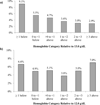Low hemoglobin levels and recurrent falls in U.S. men and women: prospective findings from the REasons for Geographic And Racial Differences in Stroke (REGARDS) cohort
- PMID: 23328832
- PMCID: PMC3640699
- DOI: 10.1097/MAJ.0b013e3182638364
Low hemoglobin levels and recurrent falls in U.S. men and women: prospective findings from the REasons for Geographic And Racial Differences in Stroke (REGARDS) cohort
Abstract
Background: There are few data available on low hemoglobin and incident falls in the general U.S. population.
Methods: Of 30,239 black and white U.S. adults ≥45 years in the population-based REasons for Geographic And Racial Differences in Stroke study, 16,782 had hemoglobin measured at baseline and follow-up data on falls. Hemoglobin was categorized by 1.0 g/dL increments relative to the World Health Organization anemia threshold (<13.0 g/dL for men, <12.0 g/dL for women). Recurrent falls (≥2 falls in the 6 months after baseline) were assessed during a telephone interview.
Results: Recurrent falls occurred in 3.9% of men and 4.8% of women. Compared with those with a hemoglobin level 1 to 2 g/dL above the anemia cut-off, multivariable adjusted odds ratios (95% confidence intervals) for recurrent falls associated with hemoglobin levels ≥3, 2 to <3 and 0 to 1 g/dL above the cut-off point, and 0 to <1 and ≥1 g/dL below the cut-off point were 0.73 (0.45-1.19), 0.84 (0.57-1.24), 1.29 (0.88-1.90), 1.32 (0.0.80-1.2.18) and 2.12 (1.23-3.63), respectively, among men (linear trend P < 0.001), and 1.59 (1.10-2.3), 1.24 (0.95-1.62), 1.42(1.11-1.81), 1.28 (0.91-1.80) and 1.76 (1.13-2.74), respectively, among women (linear trend P = 0.45; quadratic trend P = 0.016).
Conclusions: Among men, lower hemoglobin levels were associated with an increased risk for recurrent falls. Although our findings suggest an increased risk for recurrent falls at both lower and higher hemoglobin levels among women, these findings should be confirmed in subsequent studies.
Conflict of interest statement
Figures



Similar articles
-
Hemoglobin concentration and cognitive impairment in the renal REasons for Geographic And Racial Differences in Stroke (REGARDS) Study.J Gerontol A Biol Sci Med Sci. 2010 Dec;65(12):1380-6. doi: 10.1093/gerona/glq126. Epub 2010 Jul 15. J Gerontol A Biol Sci Med Sci. 2010. PMID: 20634281 Free PMC article.
-
Near-elimination of folate-deficiency anemia by mandatory folic acid fortification in older US adults: Reasons for Geographic and Racial Differences in Stroke study 2003-2007.Am J Clin Nutr. 2013 Oct;98(4):1042-7. doi: 10.3945/ajcn.113.059683. Epub 2013 Aug 14. Am J Clin Nutr. 2013. PMID: 23945721 Free PMC article.
-
Hemoglobin Concentration and Risk of Incident Stroke in Community-Living Adults.Stroke. 2016 Aug;47(8):2017-24. doi: 10.1161/STROKEAHA.116.013077. Epub 2016 Jul 5. Stroke. 2016. PMID: 27382006 Free PMC article.
-
The association between anemia and falls in community-living women and men aged 65 years and older from the fifth Tromsø Study 2001-02: a replication study.BMC Geriatr. 2017 Dec 27;17(1):292. doi: 10.1186/s12877-017-0689-8. BMC Geriatr. 2017. PMID: 29282000 Free PMC article.
-
Sex-Specific Associations Between Preoperative Anemia and Postoperative Clinical Outcomes in Patients Undergoing Cardiac Surgery.Anesth Analg. 2021 Apr 1;132(4):1101-1111. doi: 10.1213/ANE.0000000000005392. Anesth Analg. 2021. PMID: 33543869 Free PMC article.
Cited by
-
Association of anemia with mobility capacity in older adults: a Korean nationwide population-based cross-sectional study.BMC Geriatr. 2020 Nov 13;20(1):469. doi: 10.1186/s12877-020-01879-z. BMC Geriatr. 2020. PMID: 33187476 Free PMC article.
-
Readmission and mortality one year after acute hospitalization in older patients with explained and unexplained anemia - a prospective observational cohort study.BMC Geriatr. 2016 May 24;16:109. doi: 10.1186/s12877-016-0284-4. BMC Geriatr. 2016. PMID: 27221100 Free PMC article.
-
Prevalence and associated factors of anemia in a Russian population: the Ural eye and medical study.BMC Public Health. 2019 Jun 14;19(1):762. doi: 10.1186/s12889-019-7016-6. BMC Public Health. 2019. PMID: 31200672 Free PMC article.
-
Postoperative anemia in cardiac surgery patients: a narrative review.Can J Anaesth. 2024 Mar;71(3):408-421. doi: 10.1007/s12630-023-02650-9. Epub 2023 Nov 28. Can J Anaesth. 2024. PMID: 38017198 Review. English.
References
-
- Nevitt MC, Cummings SR, Hudes ES. Risk factors for injurious falls: a prospective study. J Gerontol. 1991 Sep;46(5):M164–M170. - PubMed
-
- Nevitt MC, Cummings SR, Kidd S, Black D. Risk factors for recurrent nonsyncopal falls. A prospective study. JAMA. 1989 May 12;261(18):2663–2668. - PubMed
-
- Tinetti ME, Speechley M, Ginter SF. Risk factors for falls among elderly persons living in the community. N Engl J Med. 1988 Dec 29;319(26):1701–1707. - PubMed
-
- Tinetti ME, Williams CS. Falls, injuries due to falls, and the risk of admission to a nursing home. N Engl J Med. 1997 Oct 30;337(18):1279–1284. - PubMed
-
- Tinetti ME, Williams CS. The effect of falls and fall injuries on functioning in community-dwelling older persons. J Gerontol A Biol Sci Med Sci. 1998 Mar;53(2):M112–M119. - PubMed
Publication types
MeSH terms
Substances
Grants and funding
LinkOut - more resources
Full Text Sources
Other Literature Sources
Medical

